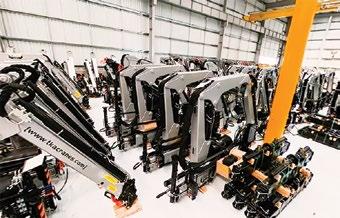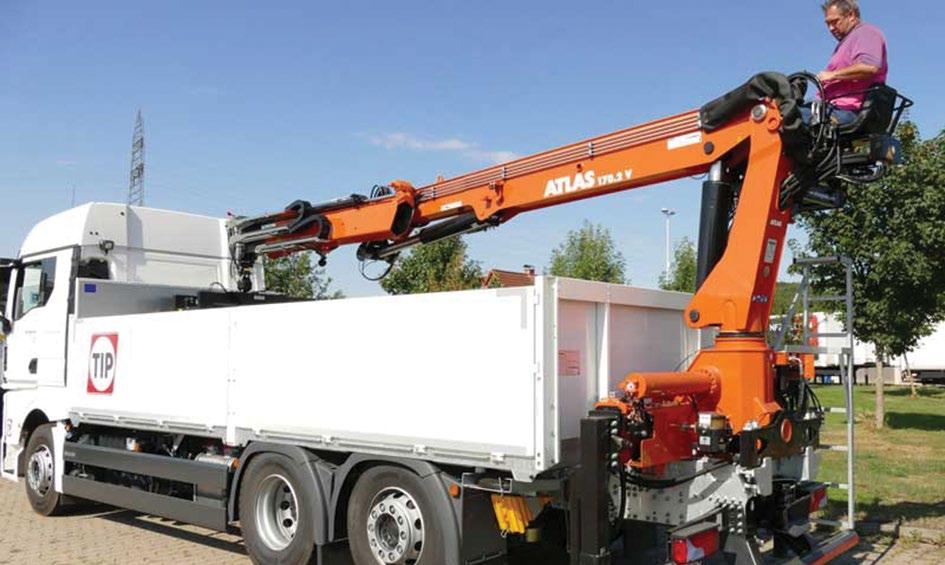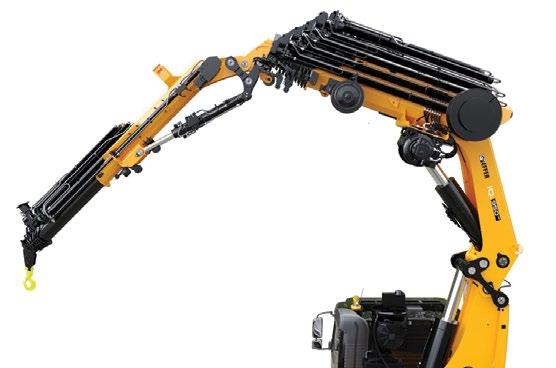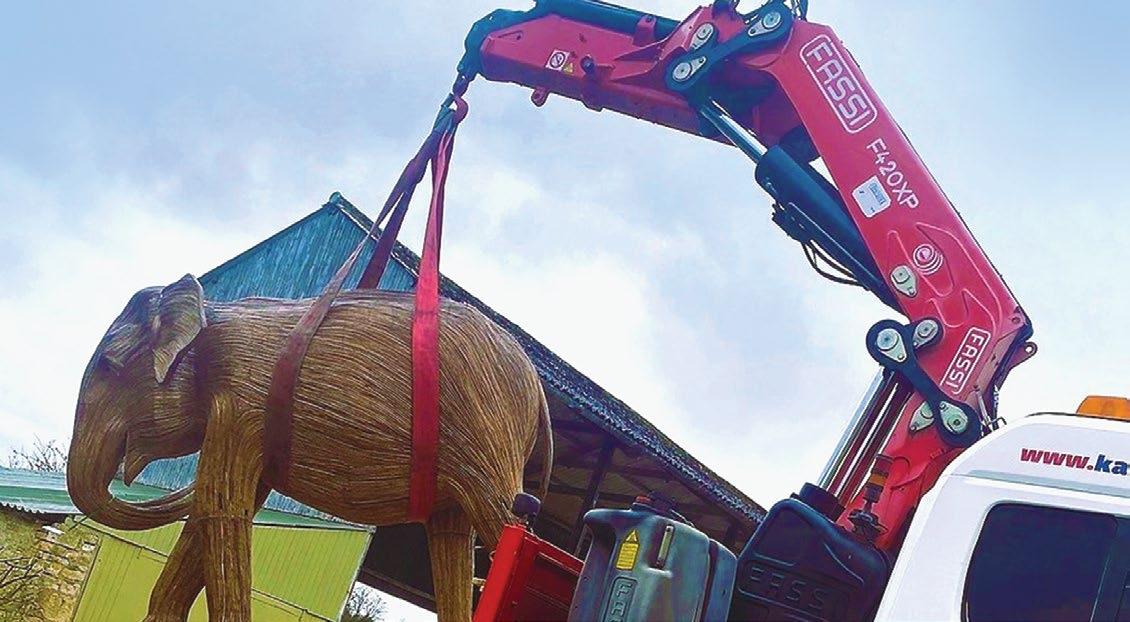
14 minute read
TECHNOLOGY DRIVING GROWTH
The loader crane market must have the most acronyms and abbreviations of any type of equipment on the market. Just glancing through any of the major manufacturers’ brochures is mind blowing, filled with abbreviations for every feature - and there are plenty of them. Palfinger has AOS, HPSC, SRC, DPS-C to name a few. Hiab uses LSS-V, ASC, VSL+, SAF and ADC. Fassi probably has more than any with IMC, ADC, CPM, FS, XF, MPES, JDP, FL, UHSS and FWD... While it is quite confusing, it demonstrates the incredible level of innovation and technology that exists within the sector - particularly with the three main manufacturers mentioned above.
Figures on the size and potential growth of the loader crane market vary considerably, however it is estimated that the global market last year was valued at almost $3 billion and is expected to increase to $5.5 billion by 2029, growing at a rate of more than nine percent a year. One trend is the growth in the medium and large product sectors - from seven to 80 tonnes. No matter what numbers you look at it would appear that production will continue to rise at an impressive pace.
North America is apparently the largest market taking about half of the total, which is odd given that most manufacturers are European based. This is followed by Europe - about 30 percent - and the remainder by Asia Pacific, South America, the Middle East and Africa… in that order.
Europe is of course dominated by the articulated loader crane or the knuckle boom if you prefer - with the straight telescopic loader cranes popular in Japan and some parts of Asia, while North America has its boom trucks, that started off as telescopic loader cranes but have now largely morphed into truck mounted cranes.
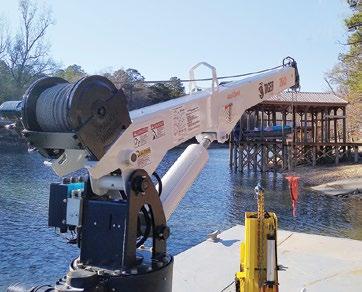
Technology driven

This is one sector of the crane market where the term mass production is justified, with the three leading European manufacturers each producing more than 10,000 units a year. This and the demands of road regulations and the fact that the operators main job is driving not crane operation, has encouraged - or rather necessitated - constant ingenuity along with the development and adoption of new technology. From the clever use of ultra-high strength steels and multi formed boom profiles to pioneering electronics result in machines that are both easier and more forgiving to use as well as improving speed and capacity - even when used by the most inept of operators.
One of the foremost innovators has been leading Italian manufacturer Fassi. Producing around 12,000 units each year it competes for market leadership with Palfinger in Austria and Hiab in Sweden although Finnish owned.
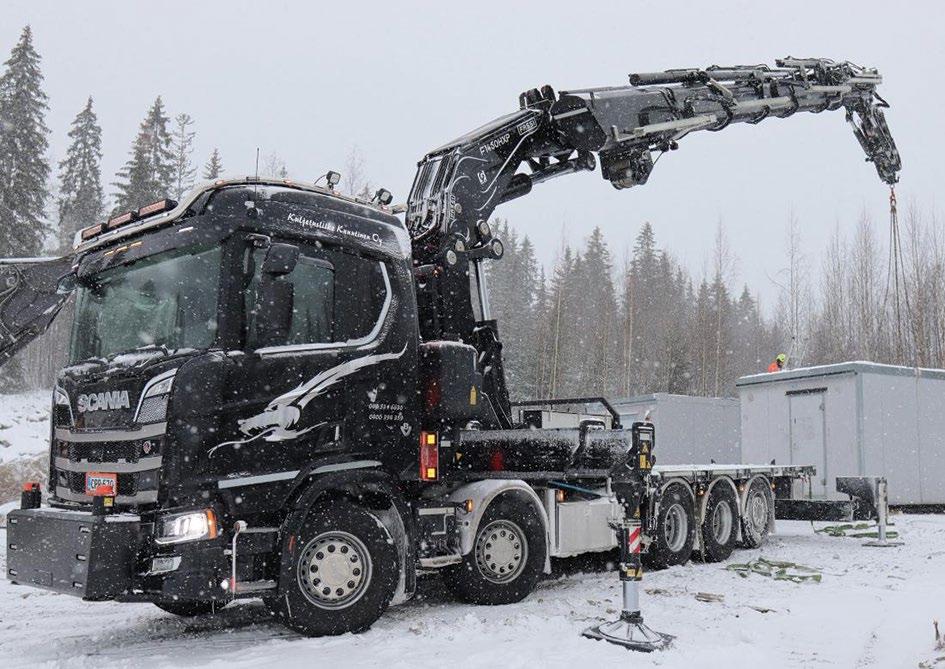
Over the past 20 years Fassi has put innovation at the heart of its business, collaborating with local universities, organisations and companies. Many years ago, it invested in an innovation centre which has recently been expanded and relocated in Nembro, Italy.
One of its long-term collaborations has been with the Intellimech Consortium, which led to its recent participation in JOiiNT Lab - a mechatronics and advanced robotics laboratory set up by Intellimech, a consortium of companies, and the Italian Institute of Technology (IIT) to advance robotics knowledge and its integration into practical applications.



Fassi has been participating in the Robot-avatar case study which allows physical activities to be carried out remotely. Two positive results from the collaboration are its ‘Next View Glasses (NVG)’ and ‘Remote Operation’. The first results were seen at Bauma last October when it set up a working ‘Remote Operation’ demonstration controlling a loader crane at its facility in Dalmine, Italy from the stand in Munich.
It has also added its new Interactive Service System, an interactive on-site support system where the on-site maintenance technician connects to the Fassi assistance centre via video, wearing ‘Smart Glasses’ connected to a headset. The glasses not only provide the Fassi support team with a first hand view, but the information they deliver back to the technician is displayed on the lens in real time and can include documents and drawings.
The Smart glasses are small and light and allow for hands free operation and feature a colour projection with a Si-OLED display. Once the battery is charged the glasses have a six hour life before needing to be recharged. The technician rings the help centre and connects via a videocall wearing the smart glasses, earpiece and microphone. A video camera integrated into the glasses remotely transmits to the Fassi service centre which then provides the necessary information and support interactively.
This emphasis on technology also shows itself in the features on its new models such as Integral Machine Control, Automatic Dynamic Control, Digital Multifunction Distributor Bank, Radio Remote Control, Fassi Electronic Control, Touch Screen Display, Fassi Stability Control, Crane Position Monitoring, Oil Temperature Control. There are also numerous ‘Performance’ and ‘Strength’ features.
Fassi has also developed new systems inspired by the ‘cranebot’. The most recent technological innovations include the FX990 control unit fitted to its Techno models, and the corresponding system FSC-Techno and the latest version of the IoC (Internet of Cranes). From sustainability and environmental impact, the recently introduced HST (Hybrid Smart Technology) has a full electric mode.
Fassi says that the North American market is showing a marked increase in the use of articulated loader cranes with the growth of new applications in mining, tree works, road construction and Oil & Gas, as well as in construction. At Conexpo the company unveiled the 132 tonne/metre F1750R.2 HXP-Techno - the second in its new Techno range - which follows the 119 tonne/metre F1450R-HXP unveiled in 2021.
The F1750R.2 HXP has a 31.8 metre maximum reach with a 30 tonne maximum capacity at four metres. The base F1750R2.4 HXP with four telescopic extensions can lift 11.94 tonnes at 10.95 metres. The eight section version can lift 5.38 tonnes at 19.35 metres. The crane has similar features to the original F1450-HXP which in base form can handle its maximum capacity of 25 tonnes at a four metre radius, and 10.1 tonnes at its maximum radius of 11.15 metres.
The new cranes include dual lift cylinders on both folding sections, a new slew ring with dual drive motors and 360 continuous slew. They also feature the new FX990 electronics and control system, complete with seven inch touch screen colour display, variable outrigger set up and V7 radio remote controller as well as a new 10 sided ultra-high yield steel boom.
Other features include Fassi’s FSC-SIII stability control system, which combines the technologies of its FSC-H and FSC-SII systems to offer two operating modes, single or dual lever.
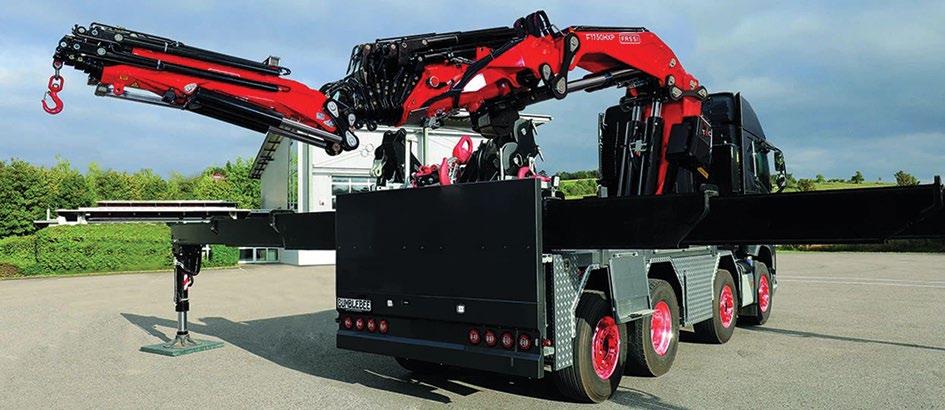
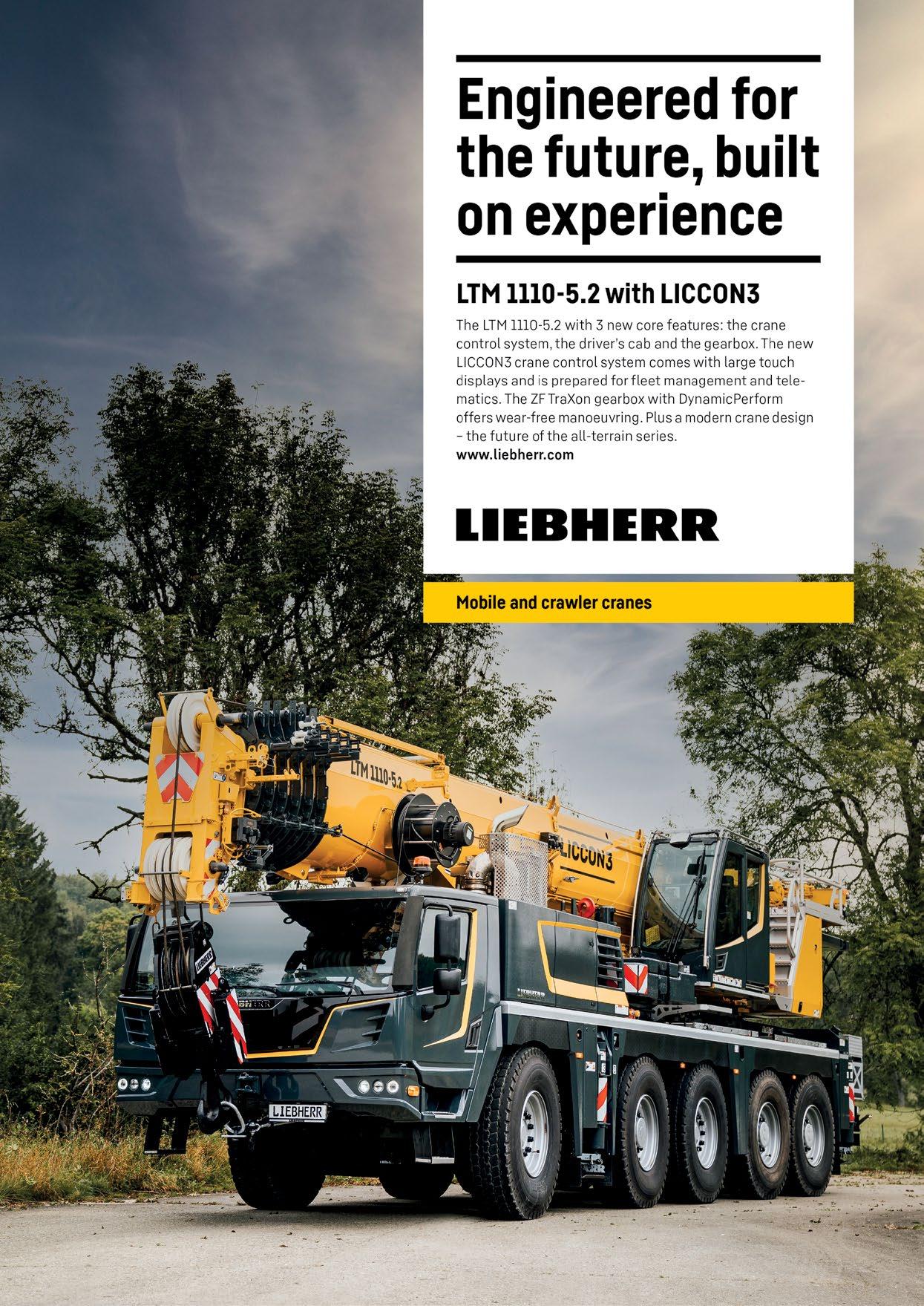
Its Jib Dual Power (JDP) function automatically monitors the load and is set up to provide the best performance. This can be manually activated or disabled using the remote controls. The SoftTend function is said to offer increased boom speeds while eliminating or reducing 'load swing' caused by an abrupt stop against the mechanical limit switch.
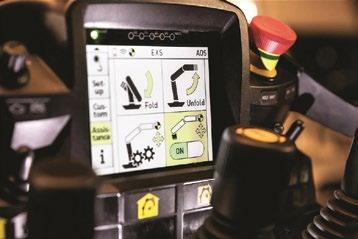
The IoC (Internet of Cranes) telematics system and DMA (Dynamic Maintenance Assistant) function allows users to view various details of the crane such as maintenance and service intervals, operator safety and machine use. The new cranes are completed with a new line of sensors that comply with EN12999 - set to come into force in 2023 - EN13849 and EN280.
Palfinger record
Austrian crane and aerial lift manufacturer Palfinger - which posted record revenues for 2022 of €2.23 billion - has also been pioneering intelligent and connected technologies with its articulated cranes. At Bauma the company highlighted digitalisation, with a focus on three key core topics - Smart Solutions, Smart Services and Eco-Efficient Solutions - all part of its Vision & Strategy 2030 to boost the services and solutions aspect of its business, thus reducing the reliance on pure manufacturing.
As part of the development the company claims to have completely redesigned its cranes “combining the advantages of its predecessors with intelligent technologies”.
Turning any operator into a pro
The new TEC Series of cranes include the new Paltronic 180 control system and the LX-6 control valve. All TEC Series cranes also include Smart Control to control the crane hook and the Memory Position system which can store up to four crane positions, as well as its Levelling Assistant for outrigger set up - all of which are aimed at being ready to unload more quickly, making operations both more efficient and simpler. Instead of moving three different levers, Smart Control allows the operator to move the crane tip either horizontally or vertically with a single lever - the technology combines separate boom and jib functions to reach the target position. Benefits include faster more precise crane control, increased productivity, lower operator stress and a reduced risk of damage to the crane or load.
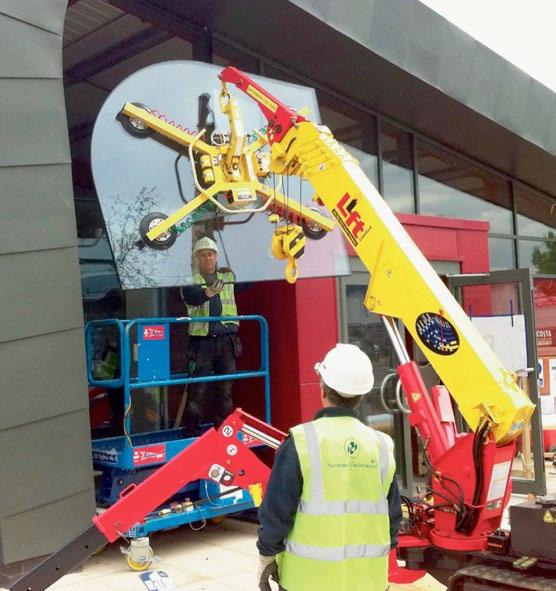
The first of the new cranes is the 60 tonne/ metre, 37 metre reach PK 580 TEC which can be combined with a mobile hybrid chassis for emission free work. When combined with a jib mounted tilting fork it can easily handle challenging work in restricted spaces. Featuring DPS-C, the lift capacity is continuously adjusted to provide maximum capacity in every position.
Other recently introduced Palfinger models include the PK 250 TEC, PK 580 TEC, PK 1050 TEC and PK 135.002 TEC 7.
Hiab parent reorganises
Hiab’s parent company, Finland’s Cargotec, is currently going through a major reorganisation with plans to separate its two core businessesKalmar and Hiab - into two completely standalone companies. Hiab of course includes Effer which it acquired in 2018.


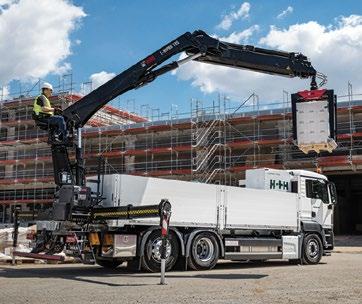
The first step involves floating Kalmar as a public company on the Nasdaq Helsinki stock market, in order to “unlock shareholder value by allowing both businesses to pursue sustainable profitable growth opportunities independently”. It is due to become a reality sometime in 2024. This will mean Hiab will return to being an independent company - albeit with a single shareholder - while Cargotec resorts to being an investment company.
As already mentioned Italian manufacturer Effer was acquired by Hiab in 2018, it then took three years before it launched its first all new crane under new ownership, the 80 to 90 tonne/metre Effer 1000 which has a maximum capacity of 25.8 tonnes at three metres or 16.8 tonnes at 4.8 metres. Development has obviously continued at a pace because in the past 12 months or so it has launched five new models including the 90 tonne/ metre Effer iQ.950 HP in February and the most recent, the 135 tonne/metre Effer iQ.1400 HP 'super heavy loader crane'.
Latest Models
The Effer iQ.1400 HP combines the V10-Force decagonal boom with up to 10 sections - base plus nine telescopic elements - providing a tip height of 25.5 metres, or a 21.48 metre radius with a capacity of 3,700kg. Maximum capacity is 30 tonnes at a 3.2 metres. It can be topped with a seven section jib, taking the maximum tip height to almost 40 metres, or a maximum radius of 33.6 metres with a capacity of 1,150kg.
The jib can be raised by 20 degrees above the horizontal with the boom elevated to 70 degrees (the maximum boom elevation is 83 degrees) and the jib horizontal. Up & over height is 26 metres with an outreach of 19 metres with a capacity of 1,300kg.
Technology wise, the SPACEevo control system includes the Load Stability System (LSS-V) which compensates for unintentionally excessive lever movement in the vertical plane, while Variable Stability Logic Plus (VSL+) provides variable outrigger set up, optimising lifting capacity by monitoring the position of and pressure in the stabiliser legs. The Dynamic Load Chart (DLC-S) reduces setup time by simulating the capacity before setting the outriggers. Owners can also access Hiab’s HiConnect telematics system that provides access to a real time view of the equipment’s condition, while monitoring its status.
Speaking of the new crane, the company said: “The high lifting capacity makes it suitable for many applications, but the possible 83 degrees working angle is perfectly suited for operations in city areas. Being able to work closer to the buildings makes it less obtrusive to the surroundings, and the boom profile reduces the side oscillations for high precision load delivery.”
Marcel Boxem of Hiab added: “Customers will be able to experience a whole new level of heavy load lifting, with a crane that excels with a vertical reach of over 39 metres. The engineering, combined with a CombiDrive4 remote control from Olsbergs gives operators unprecedented precision. The 135 tonne/metre range delivers performances similar to bigger cranes, while the smaller frame makes it suitable for installation on smaller trucks and provides plenty of payload, not normally seen in this market sector.
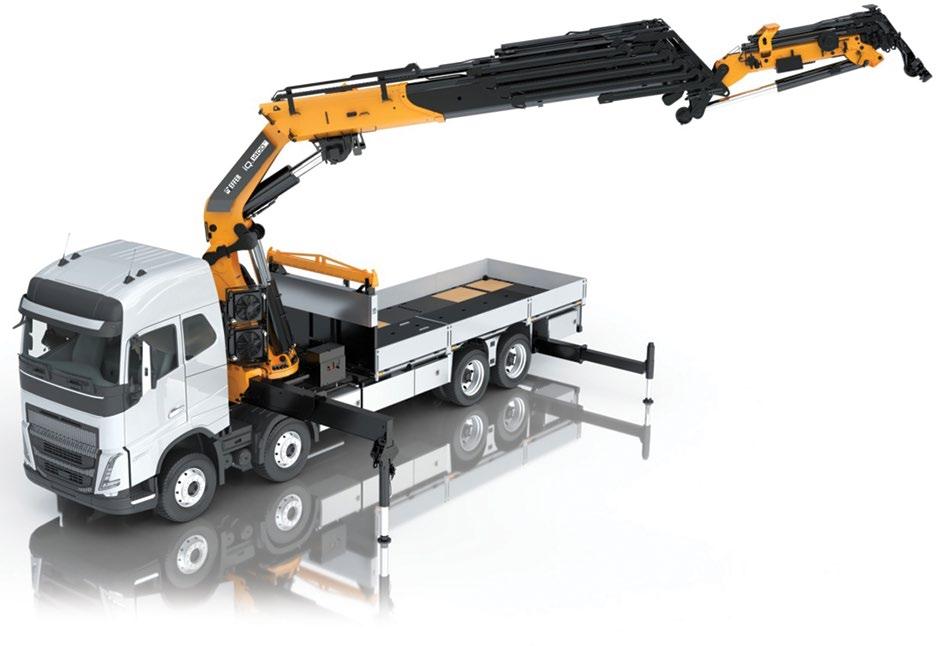

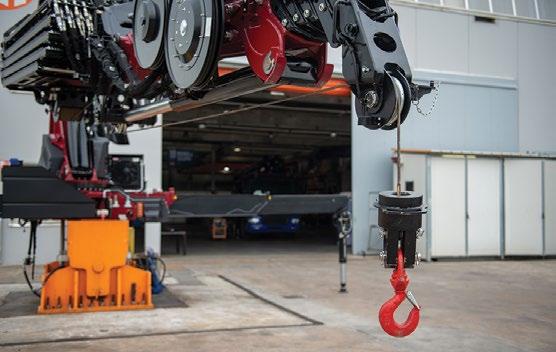
90 tonne/metre IQ.950
The 90 tonne/metre Effer iQ.950 HP features a V12-Power 12 sided boom profile and new SPACEevo operating system. It can be equipped with up to a 10 section boom, which offers a maximum capacity of 16 tonnes at 4.7 metres, and a maximum radius of 23.8 metres with a capacity of 2,340kg. If an eight section maximum luffing jib is added the maximum tip height is just over 40 metres, or with jib fully luffed and boom at maximum elevation, the crane can reach a radius of 21.7 metres at a height of 25 metres with 540kg capacity. With the boom horizontal the jib can be luffed 24 degrees above the horizontal. If an eight section boom is specified, the maximum - or nominal - capacity is 28.5 tonnes.
PM’S new heavy lIft crane
Italian loader crane manufacturer PM has launched the 59.4 tonne/metre 70.5 SP for installation on 32 or 44 tonne chassis with new features aimed at increasing efficiency and safety. Maximum capacity is just over 13 tonnes at a radius of 4.55 metres. Maximum tip height is 34.8 metres with a capacity of 580kg, which it can also handle at the maximum radius of 31.6 metres with the full eight section boom and seven section jib.
A notable feature is the ‘Smart Winch’ which automatically co-ordinates the winch operation in synchronisation with the boom and jib telescoping, preventing two-block situations. It also includes ‘Auto-Folding’ automatic crane stowage activated by pressing a button on the remote controller, reducing the risk of damaging the crane or truck/attachments during folding and unfolding of the crane, especially when the jib or other more complex attachments are installed. The features will shortly be available on all medium to large PM cranes with a digital interface. PM is also working on a load control device that helps limit or prevent load sway and swing caused by abrupt operation.
TKA
One company that is probably unfamiliar with most of our readers is TKA - one of the leading manufacturers of articulated loader cranes and access platforms in South America and market leader in Brazil, Argentina and Uruguay. Founded in 2008 it operates from a modern 6,200 square metre facility in Flores da Cunha, Rio Grande do Sul to the south of Brazil, producing in the region of 300 units a month. In 2018 it added aerial lifts. Having started exporting in 2015 it has now sold cranes across 20 countries including the USA and Mexico, while other markets include Belgium, Ghana, Thailand and New Zealand.
The company has three types of loader cranes including the European and Brazilian articulated. The 12 model European style articulated loader cranes have capacities ranging from 2.67 tonnes to 30.19 tonnes. The two largest - the 30.19 tonne, seven section TKA 66.700C and the 24 tonne, six section TKA 50.700C - are both available with four hydraulic sections and a manual section jib. The Brazilian Knuckle Boom range has up to seven hydraulic and three manual sections and up to five sections on the jib. Capacities range from 2.7 tonnes to almost 40 tonnes. ■

